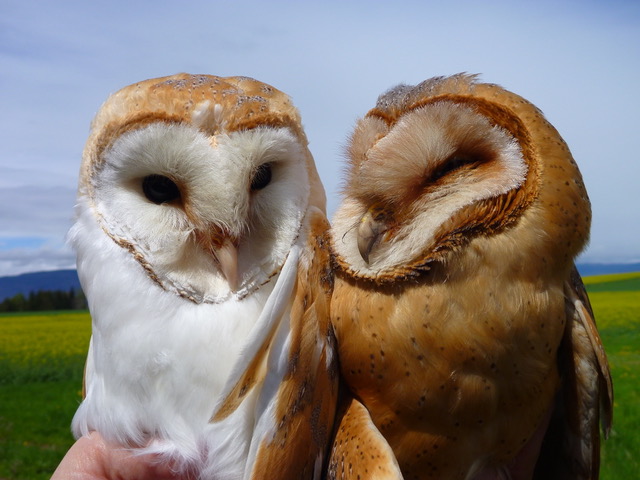by Joe Eaton

(Full article from RATS Tales March 2020)
When you’re on a back road late at night and a ghostly white apparition swoops into your headlights, the experience leaves an indelible impression—even if you know intellectually that the specter coming at you is a barn owl. At the least, you hit the brakes. According to recently published research by Swiss biologist Alexandre Roulin of the University of Lausanne and his colleagues, hitting the brakes is pretty much how voles react to the sight of a white barn owl under the full moon. The rodents freeze just a big longer than they would if the owl had reddish plumage, giving the owl more time to pounce.
For those of us to whom White Owl is a brand of cigar and Red Owl a Japanese beer, some background is in order. Found on every continent except Antarctica, the barn owl is a highly variable species, or species complex (some taxonomists consider the North American population a separate species.) In North America plumage coloration varies mostly by sex; males have white underparts, females tend toward buff. Europe is different. White-breasted owls (subspecies alba) predominate in western and southern Europe, reddish-brown owls (subspecies guttata) in eastern and northern Europe. In both forms, females are darker than males. White and red owls meet and mingle in a broad zone from the North Sea to the Alps. “Switzerland is in central Europe, and hence we have quasi [almost] as many reddish as white barn owls (and all possible intermediates)”, Roulin writes via email. He has spent years trying to determine what difference, if any, this plumage polymorphism makes for the owls’ survival and breeding success.
It turns out that plumage color correlates with a whole slew of traits. (So does the number and size of the black spots on a barn owl’s breast, a different set of complications.) Red owls prefer nest sites in open habitats; white owls favor forests. Darker owls disperse longer distances than paler owls. As nestlings, red owls are more likely to share food with their siblings than white owls. Appetite, prey preference, aggressiveness, and immune system function are all related to plumage color. However, color doesn’t seem to play a role in sexual selection. “Pairing with respect to plumage coloration is random,” says Roulin. “Thus we can find any type of pairs: white-white, red-red, and white-red.” It’s not clear if offspring of mixed pairs incur a fitness cost.
The moon study, which appeared in Nature Ecology & Evolution last fall, adds another wrinkle. When the moon is full, male red owls have lower hunting success and feed their offspring at lower levels. White owls, despite being more conspicuous in moonlight, may perform better; the survival of their youngest nestlings shows a positive relationship to the full moon. In experiments involving captive voles and taxidermied barn owls attached to a zipline, Roulin, Luis San-Jose, and their co-authors found that white plumage triggered longer freezing times in the rodents, which would allow white owls to make more kills.
That said, there’s no indication that white owls are outcompeting red owls and displacing them in the Swiss population. “The frequency of the color morphs did not really change over time,” Roulin notes. “The color variation is stable.” There may be tradeoffs that balance the odds between reds and whites. White feathers might be more susceptible to wear or less protective from weather. White owls in day roosts might be more visible targets for predators or for harassing corvids. In any case, this doesn’t seem to resemble the famous case of the peppered moth, where the frequency of light and dark forms fluctuated as industrial pollution in England made dark moths better camouflaged from predators and cleaner conditions favored pale moths.
Barn owls aren’t alone in having multiple color morphs. Plumage polymorphism occurs in other owls (Eurasian tawny owls, New World screech-owls), hawks (particularly in the genus Buteo), falcons, seabirds (jaegers, northern fulmars, wedge-tailed shearwaters, brown boobies), waterfowl (North American snow geese), and songbirds. There’s little data so far on the benefits or costs of having light or dark plumage in those species. However, studies have found correlations between color morph and blood parasite loads in nestlings of the common buzzard (a Eurasian Buteo hawk) and the tawny owl. Arjun Amar, a co-author of the moon paper who works in South Africa, has documented lower blood parasite burdens in dark morphs of the black sparrowhawk, a relative of the North American Cooper’s and sharp-shinned hawks, which may have enabled the raptor’s recent range expansion into the Western Cape region.
It’s beginning to look as if the effect of feather color is more than skin deep.
